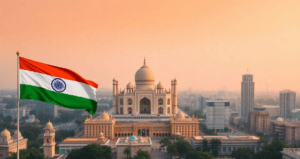India’s Economy to Soar: $7 Trillion Target by 2030 – Crucial 5 Years Ahead!
India’s economy has the potential to double to $7 trillion by 2030, with the next five years playing a crucial role in shaping its trajectory. Kaushik Shaparia, CEO of Deutsche Bank India & Emerging Asia, believes achieving 7-8% or higher annual growth is possible, but expansion alone is not enough—India must focus on inclusive growth that enhances per capita income and drives structural transformation. If the $7 trillion goal is met, per capita income could rise to around $4,500 by the decade’s end.
However, high market valuations make some investors cautious, highlighting the need for balanced economic policies. Shaparia emphasizes that attracting Foreign Direct Investment (FDI), Foreign Portfolio Investment (FPI), and Foreign Institutional Investors (FII) is essential for sustaining strong growth. Simplifying regulations and ensuring a more investor-friendly environment will be key to unlocking India’s full economic potential. By fostering sustainable and equitable prosperity, India can position itself as a global economic powerhouse.
The coming years will determine whether the country can capitalize on its strengths and turn this ambitious vision into reality.

India’s Economy to Soar: $7 Trillion Target by 2030 – Crucial 5 Years Ahead!
India’s economy has the potential to double in size, reaching an impressive $7 trillion by 2030, according to Kaushik Shaparia, CEO of Deutsche Bank India & Emerging Asia. The next five years will be crucial in determining whether the country can achieve this milestone. Shaparia believes India could grow at an annual rate of 7-8% or even faster, but he stresses that growth alone isn’t enough—it must be inclusive, boosting per capita income and driving long-term structural changes.
In an interview with The Indian Express, Shaparia emphasized that India’s economic progress should prioritize sustainable and equitable prosperity. If the country reaches the $7 trillion target, average income levels could rise to around $4,500 per person by the end of the decade. However, he also noted that global investors remain cautious due to India’s relatively high market valuations compared to other economies.
To sustain strong growth, India must continue improving its business environment for foreign investors. Whether through Foreign Direct Investment (FDI), Foreign Portfolio Investment (FPI), or Foreign Institutional Investment (FII), reducing barriers and making it easier for international capital to flow into the country will be essential. A more investor-friendly approach will play a key role in turning this ambitious economic vision into reality.
Key Factors for India’s Growth
- Inclusive Growth is Essential
While rapid economic expansion is important, Shaparia stresses that growth must benefit all sections of society. Raising per capita income and ensuring development reaches both rural and urban populations will be crucial for long-term stability. - Foreign Investment is Critical
India must attract more foreign capital by simplifying regulations, improving infrastructure, and ensuring policy consistency. Investors need confidence that their funds are secure and that returns are competitive compared to other emerging markets. - Market Valuations Concern Investors
Despite India’s strong growth prospects, some investors remain hesitant due to high stock market valuations. Addressing these concerns through improved corporate governance and transparency could help attract more long-term investments. - Structural Reforms Are Necessary
To sustain high growth, India needs deeper reforms in manufacturing, agriculture, and technology. Policies that encourage innovation, skill development, and job creation will be vital in ensuring the economy remains dynamic.
The Road Ahead
Reaching a $7 trillion economy by 2030 is an ambitious yet achievable goal if India stays focused on reforms, inclusivity, and global competitiveness. Government policies, combined with private sector participation, will determine whether the country can unlock its full economic potential.
Shaparia’s insights highlight both opportunities and challenges. If India balances growth with equity while fostering a welcoming environment for foreign investment, it could emerge as one of the world’s most powerful economies in the coming decade.
You must be logged in to post a comment.